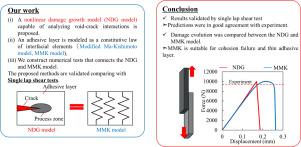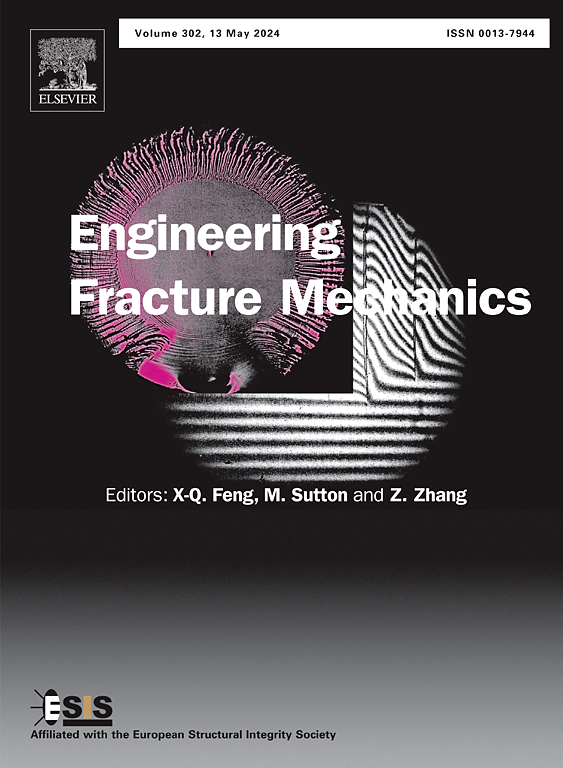热固性树脂粘合结构内聚/粘合失效的有限元建模
IF 4.7
2区 工程技术
Q1 MECHANICS
引用次数: 0
摘要
在这项研究中,我们建立了一种基于有限元法(FEM)的新方法,用于预测粘合剂结构的强度。在有限元法中引入了粘弹性、空隙增长和内聚区模型,从而建立了非线性损伤增长(NDG)模型。该模型用于全面分析粘合剂层内的加工区。此外,嵌入式加工区方法还被用于开发界面构成定律,以平均粘合剂层的机械响应。这种改良的 Ma-Kishimoto (MMK) 模型可以将粘合剂层作为界面元素进行精确表示,并且计算效率高。此外,该研究还从 NDG 模型中获得了 MMK 模型所需的界面属性,从而创建了一个可近似反映加工区影响的数值材料测试。为了验证所提出的方法,进行了单圈剪切试验,并评估了预测强度和变形场的准确性。比较了 NDG 模型和 MMK 模型的损伤演变,并讨论了 MMK 模型的应用范围。研究结果可作为热固性粘合剂失效机理和建立粘合剂结构强度设计指数的参考。本文章由计算机程序翻译,如有差异,请以英文原文为准。

Finite element modeling for cohesive/adhesive failure of adhesive structures with a thermosetting resin
In this study, we established a novel method based on the finite element method (FEM) for predicting the strength of adhesive structures. Viscoplasticity, void growth, and cohesive zone model were introduced into the FEM to create a nonlinear damage growth (NDG) model. This model was used to comprehensively analyze the process zones within the adhesive layer. Furthermore, the embedded process zone approach was used to develop an interface constitutive law that averages the mechanical response of the adhesive layer. This modified Ma–Kishimoto (MMK) model can accurately represent the adhesive layer as an interface element and is computationally efficient. Furthermore, the study obtained the necessary interface properties for the MMK model from the NDG model, creating a numerical material test that can approximate the effect of the process zone. To validate the proposed method, single-lap shear tests were performed, and the accuracy of the predicted strength and deformation field was evaluated. The damage evolution in the NDG model and the MMK model were compared, and the scope of application of the MMK model was discussed. The results of this study can be used as a reference for the failure mechanism of thermosetting adhesives and establishment of design indices for adhesive structural strength.
求助全文
通过发布文献求助,成功后即可免费获取论文全文。
去求助
来源期刊
CiteScore
8.70
自引率
13.00%
发文量
606
审稿时长
74 days
期刊介绍:
EFM covers a broad range of topics in fracture mechanics to be of interest and use to both researchers and practitioners. Contributions are welcome which address the fracture behavior of conventional engineering material systems as well as newly emerging material systems. Contributions on developments in the areas of mechanics and materials science strongly related to fracture mechanics are also welcome. Papers on fatigue are welcome if they treat the fatigue process using the methods of fracture mechanics.

 求助内容:
求助内容: 应助结果提醒方式:
应助结果提醒方式:


